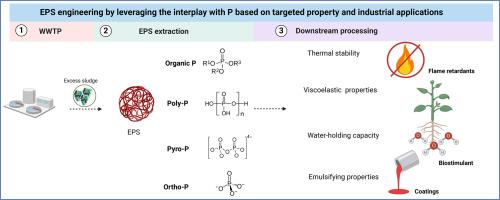Impact of phosphorus on the functional properties of extracellular polymeric substances recovered from sludge
IF 12.4
1区 环境科学与生态学
Q1 ENGINEERING, ENVIRONMENTAL
引用次数: 0
Abstract
Extracellular Polymeric Substances (EPS) are ubiquitous in biological wastewater treatment (WWT) technologies like activated sludge systems, biofilm reactors, and granular sludge systems. EPS recovery from sludge potentially offers a high-value material for the industry. It can be utilized as a coating in slow-release fertilizers, as a bio-stimulant, as a binding agent in building materials, for the production of flame retarding materials, and more. P recovered within the extracted EPS is an intrinsic part of the recovered material that potentially influences its properties and industrial applications. P is present in EPS in different speciation (e.g., P esters, poly-P, ortho-P, etc.). Such P species are already intensively used in the chemical industry to enhance thermal stability, viscoelasticity, emulsification, water-holding capacity, and many other properties of some natural and petroleum-derived polymers. The translation of this knowledge to EPS is missing which prevents the full utilization of phosphorus in EPS. This knowledge could allow us to engineer EPS via phosphorus for specific target properties and applications. In this review, we discuss how P could affect EPS properties based on experiences from other industries and reflect on how these P species could be influenced during the EPS extraction process or in the WWTPs.


磷对污泥中回收的胞外聚合物功能特性的影响
细胞外聚合物(EPS)在生物废水处理(WWT)技术中无处不在,如活性污泥系统、生物膜反应器和颗粒污泥系统。从污泥中回收EPS可能为工业提供高价值的材料。它可以用作缓释肥料的涂层,作为生物刺激剂,作为建筑材料的粘合剂,用于生产阻燃材料等。在提取的EPS中回收的P是回收材料的固有部分,可能影响其性能和工业应用。P以不同形态存在于EPS中(如P酯、聚P、邻位P等)。这类P物质已经被广泛应用于化学工业,以提高一些天然聚合物和石油衍生聚合物的热稳定性、粘弹性、乳化、保水能力和许多其他性能。缺乏将这些知识转化为EPS,从而阻碍了EPS中磷的充分利用。这些知识可以让我们通过磷来设计EPS,用于特定的目标性质和应用。在本文中,我们根据其他行业的经验讨论了P如何影响EPS的性质,并反思了这些P在EPS提取过程中或在污水处理厂中是如何受到影响的。
本文章由计算机程序翻译,如有差异,请以英文原文为准。
求助全文
约1分钟内获得全文
求助全文
来源期刊

Water Research
环境科学-工程:环境
CiteScore
20.80
自引率
9.40%
发文量
1307
审稿时长
38 days
期刊介绍:
Water Research, along with its open access companion journal Water Research X, serves as a platform for publishing original research papers covering various aspects of the science and technology related to the anthropogenic water cycle, water quality, and its management worldwide. The audience targeted by the journal comprises biologists, chemical engineers, chemists, civil engineers, environmental engineers, limnologists, and microbiologists. The scope of the journal include:
•Treatment processes for water and wastewaters (municipal, agricultural, industrial, and on-site treatment), including resource recovery and residuals management;
•Urban hydrology including sewer systems, stormwater management, and green infrastructure;
•Drinking water treatment and distribution;
•Potable and non-potable water reuse;
•Sanitation, public health, and risk assessment;
•Anaerobic digestion, solid and hazardous waste management, including source characterization and the effects and control of leachates and gaseous emissions;
•Contaminants (chemical, microbial, anthropogenic particles such as nanoparticles or microplastics) and related water quality sensing, monitoring, fate, and assessment;
•Anthropogenic impacts on inland, tidal, coastal and urban waters, focusing on surface and ground waters, and point and non-point sources of pollution;
•Environmental restoration, linked to surface water, groundwater and groundwater remediation;
•Analysis of the interfaces between sediments and water, and between water and atmosphere, focusing specifically on anthropogenic impacts;
•Mathematical modelling, systems analysis, machine learning, and beneficial use of big data related to the anthropogenic water cycle;
•Socio-economic, policy, and regulations studies.
 求助内容:
求助内容: 应助结果提醒方式:
应助结果提醒方式:


